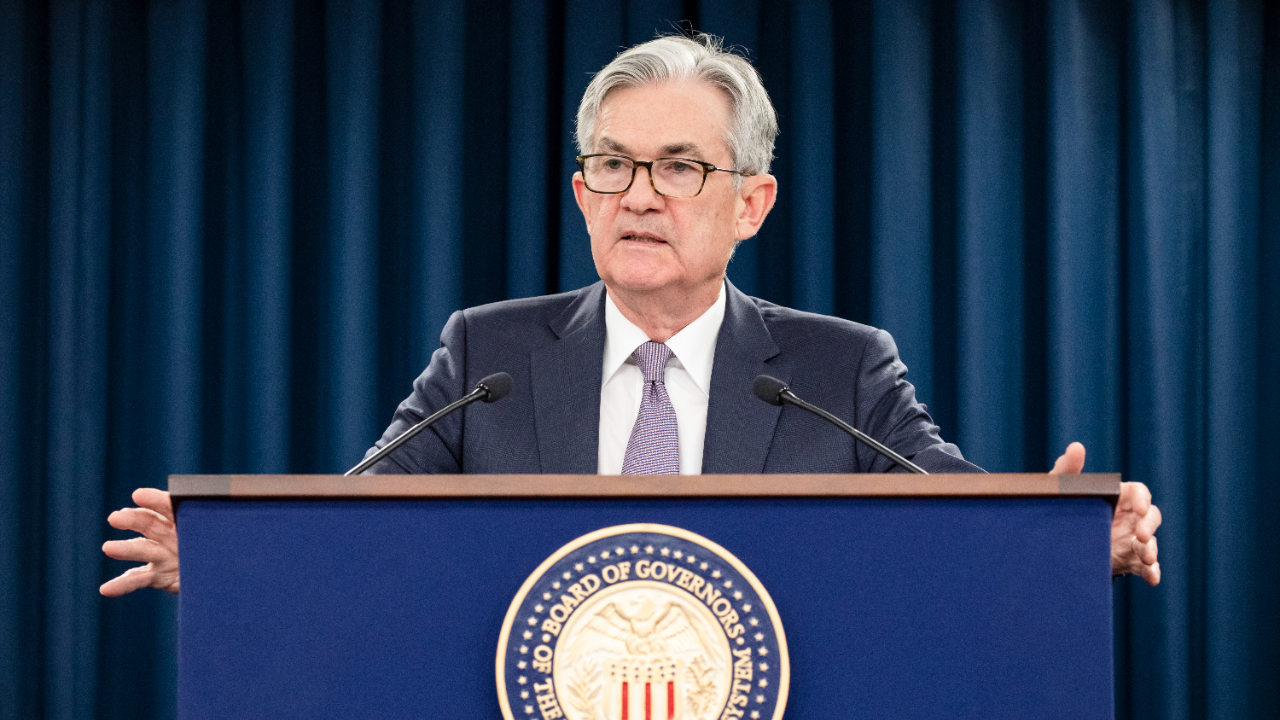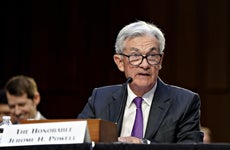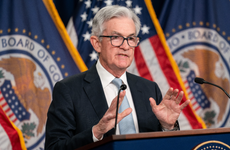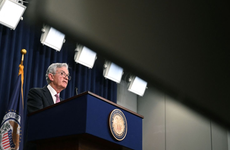Fed holds interest rates near zero, sees two rate hikes in 2023

The Bankrate promise
At Bankrate we strive to help you make smarter financial decisions. While we adhere to strict , this post may contain references to products from our partners. Here's an explanation for .
The Federal Reserve on Wednesday left interest rates at near-zero but signaled that it’s considering backing away from its easy-money policies sooner than expected, as inflation surges and growth accelerates past the effects of the devastating coronavirus pandemic.
In the U.S. central bank’s most prominent rate-setting meeting since slashing interest rates to near-zero in March 2020, officials on the Federal Open Market Committee (FOMC) are now projecting at least two interest rate hikes in 2023.
Just two months ago, officials had expected to delay that rate liftoff until 2024.
Officials also sharply upgraded their inflation and growth forecasts for 2021, with the Fed’s preferred gauge of inflation surging to 3.4 percent, then moderating back toward 2 percent over the next two years.
“Progress on vaccinations will likely continue to reduce the effects of the public health crisis on the economy, but risks to the economic outlook remain,” officials wrote in their post-meeting statement in one of the few changes to the post-meeting statement.
In another notable admission, Fed Chairman Jerome Powell indicated that officials have begun to broach the subject of slowing down their massive bond-buying program.
The Fed has been buying at least $120 billion a month of Treasury and mortgage-backed securities to keep the economy awash with credit and longer-term borrowing on products — such as mortgages — cheap. Officials planned to keep buying assets at that pace until the labor market and inflation show “substantial” progress back toward the Fed’s goals, at which point officials would slowly start to draw down those purchases in a process informally known as “taper.”
Powell, however, indicated that point is still a long way in the distance.
“The economy has clearly made progress,” Powell said in a post-meeting press conference. “I expect that we’ll be able to say more about timing as we start to see more data.”
Low savings yields will persist, but watch for higher mortgage rates
Consumers shouldn’t expect any immediate changes to how much they pay to borrow and how much they’re paid to save, which is directly influenced by the U.S. central bank. The Fed’s June rate-setting announcement means the key benchmark federal funds rate will stay in a target range of 0-0.25 percent.
Yet, mortgage rates could start to creep up, as investors and lenders gear up for a possible bond-buying slowdown and brace for higher inflation and accelerating growth. The 30-year fixed rate mortgage is more directly tied to moves in the 10-year Treasury yield. The Fed’s massive bond purchases have helped keep that interest rate low, affording homeowners significant refinancing opportunities.
Deposit yields have been at their lowest levels ever, and that’s unlikely to change anytime soon, with the Fed keeping rates at rock bottom. Banks, however, could start to slowly edge up their offerings as consumers withdraw the cash that they’ve been stashing away during the pandemic to fund post-lockdown purchases, now that travel, dining out and shopping are no longer off limits.
But the Fed’s decision to stay the course isn’t without some potential impact to your wallet. Higher inflation risks significantly eating into your purchasing power, regardless of how long it lasts. Now’s the time to take steps to hedge against higher prices by maintaining a diversified portfolio. If you’re a consumer, bracing for inflation means finding ways to free up cash while also still saving for tough economic times.
“Why is the Fed remaining so accommodative in the face of higher inflation? They still believe inflation is transitory and notably, their unemployment forecasts were little changed since March,” says Greg McBride, CFA, Bankrate chief financial analyst. “So while the economy and inflation have revved up, in the eyes of the Fed their assessment of the job market is not much different now than it was in March.”
The Fed’s nightmare scenario: Higher inflation and a troubled labor market
At this point in the coronavirus recovery, the Fed’s twin goals of maximum employment and stable prices are butting heads.
On the one end, millions of Americans are still facing worsened job prospects. Some 15 million Americans are drawing unemployment insurance, another 3.5 million dropped out of the labor force altogether during the pandemic, and U.S. employers have 7.7 million fewer positions on their payrolls than they did before the outbreak put a wedge in the gears of commerce.
At the same time, prices are surging. Consumer prices rose by the most since 2008, while the Fed’s preferred gauge of inflation had its fastest burst in 28 years.
Inflation was always expected to rise this year, with the year-over-year rise exacerbated by last year’s below-average readings, along with supply bottlenecks, reduced production capacity and strong demand from consumers who’ve been locked down in their homes for more than a year.
While most of the price gains have been concentrated in pandemic-ravaged sectors from airline tickets to meals away from home, inflation has still risen faster than the 2.4 percent annual rate that officials initially expected back in March 2021, the last time the FOMC upgraded their economic projections.
Complicating that picture are ongoing frictions in the labor market. Powell has reiterated that a tight labor market is a recipe for a sustained bout of higher inflation as employers hike wages to recruit more talent. Elevated unemployment suggests it’s a hard time to find a position, though companies are already complaining that they’re having a hard time filling job openings.
An April report from the Department of Labor seemingly complemented those complaints, with job openings rising to a record in the month and nearly matching the number of individuals currently seeking work.
The risk is that the labor market might be tighter than expected. Experts say enhanced unemployment benefits, virus fears and ongoing child care issues are combining to keep potential workers at home. Those should fade eventually as the pandemic creeps further into the rearview mirror. Yet, some individuals could have retired, households might’ve judged that they can get by with fewer hours or members employed, shrinking the labor supply.
“It’s not a time to try to reach hard conclusions about the labor market, about inflation, about the path of policy,” Powell said of the reopening frictions. “We need to see more data; we need to be a bit patient.”
The Fed’s ultimate goal is to be as patient as possible as it waits for the noise to quiet down. Raising interest rates too soon risks slowing down the economy needlessly, keeping millions of more Americans out of work. Higher inflation and easy-money policies, however, risk forming asset bubbles and raising financial stability concerns.
Dialing back support is the main way the Fed can prevent the economy from overheating, something the U.S. central bank doesn’t want to do as millions of Americans still face diminished job prospects. Experts say it’s easier to clean up inflation and zap asset bubbles from the economy than it is to take back a rate hike if the Fed were to ultimately act too soon.
Stocks sank and the 10-year Treasury rose on the news.
“It’s a question of how committed the Fed is to this,” says Tom Garretson, CFA, senior portfolio strategist at RBC Wealth Management, referring to the U.S. central bank’s accommodative monetary policy stance. “The Fed has always been hyperfocused on inflation to their detriment, given its shortfalls over the past decade. … At the end of the day, their focus is going to be on the labor market. They will tolerate inflation above 2 percent more than credit markets give them credit for.”
In the news conference, Powell pushed back against another concern: that the Fed may end up playing a faster game of catch up with rate hikes down the road to prevent the economy from overheating, possibly triggering a recession.
“Whenever liftoff comes, policy will remain highly accommodative,” Powell said.
“Chair Powell did emphasize in his comments that once the conditions for tightening monetary policy are achieved, the pace of tightening is likely to be modest,” says Ben Ayers, senior economist at Nationwide. “This implies that interest rate hikes could be spread out to minimize the disruptions for the economy and could extend the current expansion.”
What this means for you
In the near-term, inflation poses the biggest risk to your wallet, and the steps you should take to safeguard your cash differ depending on whether you’re a consumer or an investor.
Keep a diversified portfolio that includes some historically inflation-safe investments, from dividend-paying stocks and preferred stocks to real estate investment trusts. Avoid parking too much cash in fixed-income investments, such as bonds, which tend to be more sensitive to price increases.
Prices have soared the most on fuel, used vehicles, airline fares and apparel, meaning consumers who are hoping to avoid a hit to their wallet from inflation might consider delaying those purchases — or at least bracing for them by saving ahead of time. While it seems counterintuitive, consumers shouldn’t stop saving or contributing to an emergency fund with the threat of their purchasing power eroding. Higher inflation periods tend to bring about greater economic uncertainty that you want to be prepared for with a sleep-well-at-night fund.
Experts also say concerns about higher inflation make it an important time to refinance your mortgage. Doing so can help you lock in a lower rate and payment for the life of the loan that also frees up cash to pay for other necessities that are rising in cost.
You haven’t missed your chance to lock in a historically low rate if you’re still considering refinancing or purchasing a home. With the Fed keeping its bond-buying plans intact, for now, mortgage rates are unlikely to rise too drastically above their historically low levels. But any kind of bond-buying plan adjustment could have implications for higher mortgage rates, meaning you shouldn’t sit on your hands for too long.
Even just the idea of higher growth can trigger rate increases. For example, the 30-year fixed-rate mortgage crept up in February after the benchmark 10-year Treasury yield rose to levels not seen since before the pandemic as investors reacted to news of a sharper economic recovery.
Consumers with high-cost credit card debt will be better off if they can eliminate their overhanging balances now, while rates are still low. Analyze how much you would save in interest by estimating the cost of transferring your debt to a balance-transfer card.
While the U.S. economy is in much better shape now than it was a year ago, many consumers are still financially struggling. If you’re facing joblessness, consider tapping into your professional network while also staying in touch with lenders and firms that you regularly pay a bill to, so you can negotiate an individualized forbearance program to help eliminate expenses.
Fed officials still expect that joblessness will fall to 4.5 percent by the end of the year, sticking with forecasts from their previous March projections. The unemployment rate, however, is expected to return to its pre-pandemic, half-century low of 3.5 percent by 2023.
“I am confident that we are on a path to a very strong labor market,” Powell said.
Learn more:
Related Articles

The economy has avoided a recession so far — and it could be a nightmare for the Fed


Fed hikes interest rates by three-quarters of a point to combat decades-high inflation

Fed sticks with zero interest rates, even as inflation concerns mount